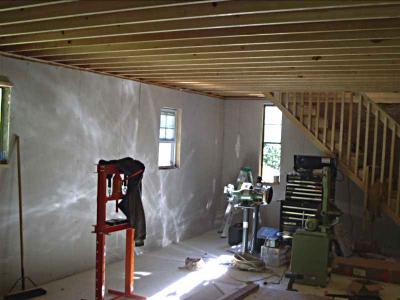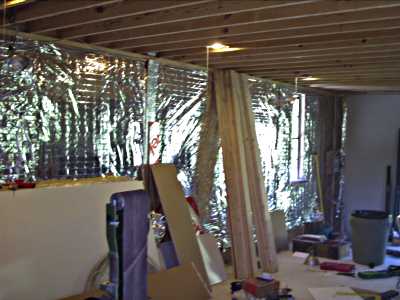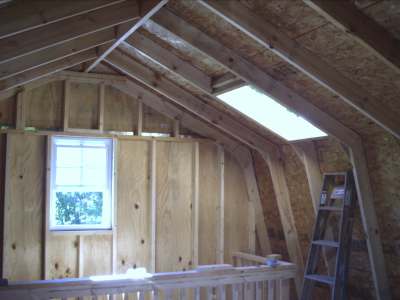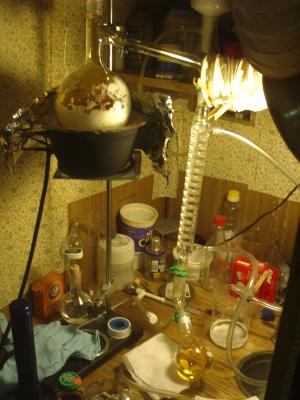C-Lab is expanding!
We have decided that space is the next frontier. We just didn't
have enough of it anymore, which is one reason we've resisted putting
pictures of our current office up on the web. It's messy beyond
belief, with a 12+ machine network (lots of kvms to support 4 stations),
electronics fab, chemistry/electroplating and benchrest reloading all in
one 400 sq foot office building. Yes, there are a couple of other
buildings for storage and infrastructure support, but not nearly
enough. Doug, the owner, therefore decided to give up some of the
front yard of the current office to a new building. To get this
done quickly and economically, we decided to go with a building from
Classic Manor Builders catalog, available at Home Depot stores.
They build on your site, to your specifications, more or less -- you do
the foundation, permits and so on. In our case, they did a fine
job, and did it pretty quickly despite rainy weather and other
obstacles, using our solar power to run their tools. We selected a
"New Dawning" two story 1024 sq foot model from their catalog, as this
was about the best square feet per dollar they had, coming in at about
$16/sq ft, unfinished. It'll be more like $20/sq ft once we are
done. We will be moving all but the software lab out of the
current spaces and into this building, which will also a new machine
shop and some new photolithographic toys for selective
electroplating, metal etching, and some new physics apparatus.
Although slow to download, pictures are worth lots of words, so here are
a few of the building in progress. Our solar panels will soon be
moved to the top of this building, which was sited to aim the upper roof
in the ideal fashion for this use. There, they will get
about 2 more hours a day of sun, as morning and afternoon tree shadows
will be less than now.

Here one of the builders is putting on the last few shingles.
We've since added some more windows, found at a dumpster, of course,
it's just amazing what people will toss out.
He's using a nail gun run by our 2Hp compressor to do it. As you
can see, we'll have to add skirting to the basement area, which will get
the contents of the energy shed and and air
compressor put into it. That will get them protected from the
weather better, and should cut down the noise we hear as well.

Here is some of the ground floor, after laying tile and some of the
drywalling. The machines in this picture are from Harbor Freight
(buyer beware, I touched these in the store before buying them) and the
toolbox is a Clarke from Tractor Supply. I've been finding the
Clarke stuff to be a very good value, well made where it counts. I
got a floor standing drill press from them that has no play whatever in
the quill and a rotary table, for under $150. Good stuff.
The cool reflection on the wall is from a piece of space blanket scrap
on the floor. For an example of the variable quality at Harbor
Freight, the grinder and buffer are on the $19 stands, which are far
superior in all ways to the $59 ones at the same place. Go figure
-- but go to the store before you buy. If the "3/4 Hp" 8" grinder
really is, I'll eat it without salt -- it may draw that much current,
and must change most of that into internal heat, but the grinder buffer
(same rating) really does have the shaft power. Their Foredom
"copycat" tool is pretty good also, at a fraction of the price of the
real thing. Unlike the basic Dremel, or the air powered version
(Home Depot) the tool has nice torque even at low speeds.

Here's the other end of the ground floor, pre drywall. We found
it hard to find aluminum backed fiberglass locally, and found the
cheapest IR reflector/vapor barrier to be "Space Blankets" available at
Wal Mart in sporting goods for a couple bucks each. Not in this
picture or above are the milling machine (Harbor Freight) and metal
bandsaw (Clarke), it's a big room! A lathe is soon to come, it
sometimes takes awhile for things to get here from China. Although
not shown, the doors are large enough to accept my friend's hot rods and
suchlike, for advanced puttering. Welding (gas, stick, mig at
present) will be done under the front porch awning, to be installed soon.

Here's one end of the upper floor, as of 9/23/04. Not shown is
the internet satellite uplink and firewall already installed. Doug
put in the skylight so as to be able to get on to the roof without
climbing 30 foot wobbly ladders while carrying solar panels. This
room will get the electroplating/photolith/chemistry/physics stuff, and
a small electronics fab. We'll probably put in another skylight,
since this one provides nice light and better ventilation than a big fan
in the window.
More to come! At some point this will be "done" and we will put
up pictures of that, instead, after moving all the cool stuff in, like
the chemistry set shown below, which is currently in a little cubby in
the main office that used to be a closet.

Yes, that is 100% fuming nitric acid in the lower flask, about 100 ml
worth, just before using it to make PETN, an interesting high explosive
I am using for explosive microwelding -- imagine putting things
together with explosives, rather than taking them apart! Thanks to
my friends at FBI and other agencies for making this possible and
permissable. You can't buy this acid, it is too unstable to ship
even after defuming it with urea, air and heat. That's why you can
only buy 70% from the supply houses. One makes this stuff
(Carefully!!!) and uses it right away, usually chilled well below room
temperature. Although this is a vacuum distillation process, we
have the dryer hose pulling 500 cfm to the outdoors just in case some
fumes should escape. This is very wicked stuff. The nitrile
gloves shown, and safety glasses aren't enough to protect you from
it. The resulting high explosives are far safer to deal with, they
are just flammable, and usually poisonous. Most of them need to be
hit pretty hard before they'll go bang. We are using components
from our high energy phyics toybox to eliminate the need for
dangerous/toxic primary explosives like mercury fulminate and lead azide
for big shots, although the latter may wind up being used alone for
microwelding in the future. Too bad we couldn't just use a chip
slapper for the microwelding, as the things we want to microweld
couldn't stand the EMP this generates.
More to come!




